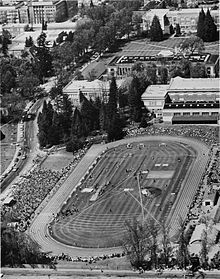Bell Field

Aerial view of track meet from the southeast
|
|
| Full name | Bell Field |
|---|---|
| Location |
Oregon State University SW 26th Street & SW Washington Way Corvallis, Oregon, U.S. |
| Coordinates | 44°33′47″N 123°16′44″W / 44.563°N 123.279°WCoordinates: 44°33′47″N 123°16′44″W / 44.563°N 123.279°W |
| Owner | Oregon State University |
| Operator | Oregon State University |
| Capacity | 21,000 |
| Surface | Natural grass infield (1937–1974) Dirt / sawdust (1910–1936) |
| Opened | 1910, 107 years ago |
| Closed | 1974 |
| Tenants | |
|
Oregon State Beavers football (1910–1952) Oregon State Beavers track and field (1911–1974) |
|
Bell Field, originally known as College Field (1893–1909), was an outdoor athletic stadium in the northwest United States, on the campus of Oregon State College (now University) in Corvallis, Oregon. It was the home venue of Oregon State Beavers football prior to the opening of Parker Stadium (now Reser Stadium) in November 1953.
Opened 107 years ago in 1910, Bell Field had a seating capacity of 21,000 at its peak and was named after J.R.N. "Doc" Bell, an early supporter of the college and its athletic teams. With a conventional north-south orientation, its low-profile seating was mostly covered in a horseshoe configuration, opening to the north, at an elevation of 230 feet (70 m) above sea level.
After Parker Stadium opened, most of the seating was removed, but it hosted the school's track and field program on a cinder track until March 1974, after which it was torn down. It was located directly west of the baseball field (today's Goss Stadium at Coleman Field) and parallel to its first base line. The Dixon Recreation Center, opened in 1976, occupies the site.
A natural grass field for football was first installed at Bell Field in 1937; the surface was previously a mixture of dirt and sawdust. That field surface was not unique in the Northwest in the Pacific Coast Conference: Hayward Field in Eugene, Multnomah Stadium in Portland, and Husky Stadium in Seattle made similar transitions to natural grass in this period of time.
...
Wikipedia
